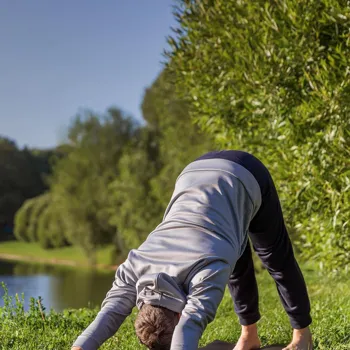Explore 7 Simple Breathing Techniques to Beat Stress & Calm Your Mind. Enhance well-being effortlessly
In today's fast-paced Bharat, stress has become as common as chai. From deadlines at the office to managing
family responsibilities, life can feel like a never-ending race. But before you pop another pill or reach for that extra cup of coffee, consider a simpler, more natural solution: breathing.

Yes, something we do automatically all day long can be a powerful tool for managing stress and promoting overall well-being. This article will guide you through seven simple breathing techniques that you can easily incorporate into your daily routine to calm your mind and conquer stress.
So, take a deep breath and let's begin!
Become aware of your breath to manage stress effectively
The first step towards managing stress through breathing is simply becoming aware of your breath. Most of the time, we breathe unconsciously, without paying attention to the rhythm or depth of our breaths. This technique encourages you to pause and observe your natural breathing pattern.

Find a comfortable position, either sitting or lying down. Close your eyes gently and bring your attention to your breath. Notice how the air enters your nostrils, fills your lungs, and then exits your body. Don't try to change your breathing; just observe it.
Pay attention to the rise and fall of your chest or abdomen. What is the pace of your breath? Is it shallow or deep? Are you breathing through your nose or your mouth? Simply acknowledging your breath without judgment can be surprisingly calming.
Do this for just a few minutes each day, and you'll start to notice subtle shifts in your stress levels and overall sense of calm.
Diaphragmatic breathing for relaxation and stress reduction
Often called "belly breathing," diaphragmatic breathing is a technique that utilizes the diaphragm, a large muscle at the base of your lungs, for deeper and more efficient breathing. Many of us tend to breathe shallowly, using only the upper part of our lungs.
This can contribute to feelings of anxiety and stress. To practice diaphragmatic breathing, lie down on your back with your knees bent and your feet flat on the floor. Place one hand on your chest and the other on your abdomen.
As you inhale slowly through your nose, focus on expanding your abdomen, allowing the hand on your stomach to rise while keeping the hand on your chest relatively still. As you exhale slowly through your mouth, gently contract your abdominal muscles, allowing the hand on your stomach to fall.
The hand on your chest should remain relatively still. Continue this slow, deep breathing for 5-10 minutes. Feel the relaxation spread through your body.
This technique helps to activate the parasympathetic nervous system, which is responsible for the "rest and digest" response, promoting relaxation and reducing stress.
Step 3
Alternate Nostril Breathing (Nadi Shodhana) - Balancing Your Energy

Traditional technique balances brain hemispheres for calm and clarity
Alternate nostril breathing, or Nadi Shodhana Pranayama, is a traditional yogic breathing technique that helps to balance the left and right hemispheres of the brain, promoting a sense of calm and equilibrium. To practice this technique, sit comfortably with your spine straight.
Close your right nostril with your right thumb. Inhale slowly and deeply through your left nostril. Then, close your left nostril with your right ring finger and release your right thumb, exhaling slowly through your right nostril.
Inhale through your right nostril, close it with your right thumb, and release your left ring finger, exhaling through your left nostril. Continue alternating nostrils for 5-10 minutes, focusing on the smooth and even flow of your breath.
This technique is believed to clear energetic blockages and promote mental clarity, reducing stress and anxiety. Regular practice can lead to a more balanced and harmonious state of mind. Remember focus on smooth and gentle breaths, avoid forcing or straining.
Box breathing: a technique for stress relief and focus in high-pressure situations
Box breathing, also known as four-square breathing, is a simple yet powerful technique used to promote focus and reduce stress in high-pressure situations.

It involves breathing in, holding your breath, breathing out, and holding your breath again, each for the same duration, creating a "box" pattern. Find a comfortable seated position. Inhale slowly and deeply through your nose for a count of four. Hold your breath for a count of four.
Exhale slowly and completely through your mouth for a count of four. Hold your breath again for a count of four. Repeat this cycle for 5-10 minutes, focusing on maintaining the rhythm and evenness of your breath.
This technique helps to regulate the nervous system, slow down the heart rate, and promote a sense of calm and control. It's particularly effective for managing anxiety and improving focus before important tasks or during stressful situations.
It’s a great tool for students before exams, or anyone facing a demanding situation.
Practice Brahmari Pranayama for stress relief and relaxation
The Humming Bee Breath, or Brahmari Pranayama, involves making a gentle humming sound while exhaling, mimicking the sound of a bee. This technique is particularly effective for calming the mind and reducing stress and anxiety. Sit comfortably with your eyes closed.
Close your ears with your thumbs, placing your index fingers lightly on your eyebrows and your other fingers on your cheeks. Inhale deeply through your nose. As you exhale slowly, make a gentle, continuous humming sound like a bee (mmmm…).
Feel the vibration of the sound throughout your head and chest. Repeat this for 5-10 minutes, focusing on the sound and the sensations in your body. The humming sound helps to slow down the mind, reduce mental chatter, and promote a state of deep relaxation.
It's also believed to have a calming effect on the nervous system, helping to alleviate stress and improve sleep. This pranayama is a good antidote to noisy, chaotic environements.
Lion's Breath: unique breathing exercise for stress relief
Lion’s Breath, or Simhasana, is unique as it involves both breath and physical expression to release pent-up tension and energy. It might seem a bit silly at first, but it’s a powerful way to let go of stress. Kneel down comfortably, placing your hands on your knees or the floor.
Inhale deeply through your nose. As you exhale forcefully through your mouth, open your mouth wide, stick out your tongue towards your chin, and roar like a lion. At the same time, widen your eyes and tense the muscles in your face.
Repeat this several times, feeling the release of tension with each exhale. This breathing technique is a wonderfully cathartic way to release pent-up emotions and physical tension, promoting a sense of freedom and well-being.
While perhaps not best in a crowded office, it's perfect for a private space where you need to relieve built-up frustration.
Practice Sitali breath to cool body and mind effectively
Sitali breath is all about cooling the body and mind using a unique tongue technique. This might sound strange, but it can be very effective, particularly in hot weather or when you're feeling overheated and stressed. The practice cools your body. Sit comfortably with your spine straight.

Extend your tongue out of your mouth and curl the sides of your tongue inwards to form a tube shape. If you can't curl your tongue, simply purse your lips as if you're about to whistle. Inhale slowly and deeply through the curled tongue or pursed lips, imagining that you're drawing in cool air.
Close your mouth and exhale slowly through your nose. Repeat this for 5-10 minutes, focusing on the cooling sensation in your mouth and throat. This technique helps to lower body temperature, calm the mind, and reduce feelings of irritability and anxiety.
It's a fantastic way to find relief during hot summer days or whenever you need a quick cooling and calming effect. It works especially well after a particularly stressful meeting or commute.
Breathing techniques for stress management and well-being
These seven simple breathing techniques are invaluable tools for managing stress and enhancing your overall well-being. Incorporate them into your daily routine, even for just a few minutes each day, and experience the transformative power of conscious breathing. Remember, consistency is key.

With regular practice, you'll be better equipped to handle life's challenges and navigate stressful situations with greater calm and resilience. So, breathe deep, relax, and embrace the present moment!
AI Generated Content. Glance/InMobi shall have no liability for the content











